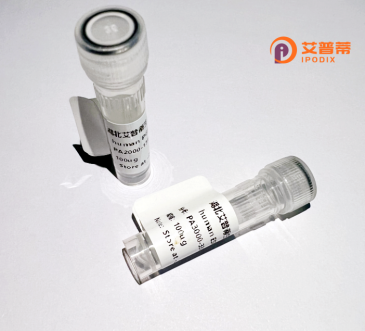
| 纯度 | >90%SDS-PAGE. |
| 种属 | Human |
| 靶点 | OR51E1 |
| Uniprot No | Q8TCB6 |
| 内毒素 | < 0.01EU/μg |
| 表达宿主 | E.coli |
| 表达区间 | 1-317 aa |
| 活性数据 | MVDPNGNESSATYFILIGLPGLEEAQFWLAFPLCSLYLIAVLGNLTIIYIVRTEHSLHEP MYIFLCMLSGIDILISTSSMPKMLAIFWFNSTTIQFDACLLQMFAIHSLSGMESTVLLAM AFDRYVAICHPLRHATVLTLPRVTKIGVAAVVRGAALMAPLPVFIKQLPFCRSNILSHSY CLHQDVMKLACDDIRVNVVYGLIVIISAIGLDSLLISFSYLLILKTVLGLTREAQAKAFG TCVSHVCAVFIFYVPFIGLSMVHRFSKRRDSPLPVILANIYLLVPPVLNPIVYGVKTKEI RQRILRLFHVATHASEP |
| 分子量 | 35.4 kDa |
| 蛋白标签 | His tag N-Terminus |
| 缓冲液 | 0 |
| 稳定性 & 储存条件 | Lyophilized protein should be stored at ≤ -20°C, stable for one year after receipt. Reconstituted protein solution can be stored at 2-8°C for 2-7 days. Aliquots of reconstituted samples are stable at ≤ -20°C for 3 months. |
| 复溶 | Always centrifuge tubes before opening.Do not mix by vortex or pipetting. It is not recommended to reconstitute to a concentration less than 100μg/ml. Dissolve the lyophilized protein in distilled water. Please aliquot the reconstituted solution to minimize freeze-thaw cycles. |
以下是关于重组人 **OR51E1** 蛋白的3篇参考文献及简要摘要:
---
1. **文献名称**: *"Olfactory receptor OR51E1 mediates glandular prostatic cell differentiation"*
**作者**: Kalbe B, et al.
**摘要**: 发现OR51E1在前列腺上皮细胞中高表达,并参与调控前列腺细胞分化和功能,提出其可能通过调节雄激素受体信号通路影响前列腺稳态和肿瘤发生。
2. **文献名称**: *"Ectopic olfactory receptor expression and therapeutic potential in gastrointestinal stromal tumors"*
**作者**: Maßberg D, et al.
**摘要**: 研究显示OR51E1在胃肠道间质瘤(GIST)中异常高表达,激活该受体可诱导肿瘤细胞凋亡,提示OR51E1作为肿瘤特异性靶点的治疗潜力。
3. **文献名称**: *"The olfactory receptor OR51E2 activates β-catenin signaling and promotes metastasis in prostate cancer"* (注:OR51E2是OR51E1的别名)
**作者**: Neuhaus EM, et al.
**摘要**: 揭示OR51E1(OR51E2)通过激活β-catenin信号通路促进前列腺癌细胞迁移和转移,其过表达与患者预后不良相关。
---
**注**:OR51E1研究多聚焦于非嗅觉组织的功能,如肿瘤和前列腺疾病。如需更具体的重组蛋白表达方法学文献,建议补充“OR51E1重组表达”或“结构解析”等关键词进一步筛选。
**Background of Recombinant Human OR51E1 Protein**
OR51E1. a member of the olfactory receptor (OR) family, is a G protein-coupled receptor (GPCR) initially identified for its role in odorant detection. Despite its classification as an olfactory receptor, OR51E1 exhibits broad tissue expression, notably in non-olfactory tissues such as the prostate, colon, and pancreas. This receptor has garnered attention for its potential involvement in non-chemoreceptive functions, including cell proliferation, differentiation, and cancer progression.
In prostate cancer, OR51E1 (also termed *PSGR2*) is overexpressed and implicated in tumorigenesis, potentially acting through pathways like MAPK/ERK or influencing cellular metabolism. Its dual role—chemoreception and signaling in disease—highlights functional versatility beyond traditional OR roles.
Recombinant OR51E1 protein is typically produced using heterologous expression systems (e.g., HEK293 or insect cells) to study its structure, ligand interactions, and signaling mechanisms. Purified recombinant variants often include tags (e.g., GFP, His-tag) for detection and isolation. Research leverages this protein to decipher its physiological ligands, downstream effectors, and therapeutic potential in cancers or metabolic disorders.
Current challenges include identifying endogenous ligands and clarifying its context-dependent signaling. OR51E1 remains a compelling target for both basic GPCR biology and translational studies in oncology.
×